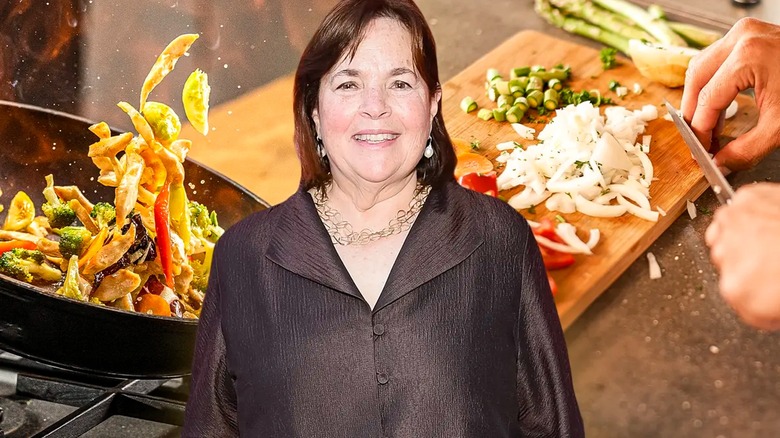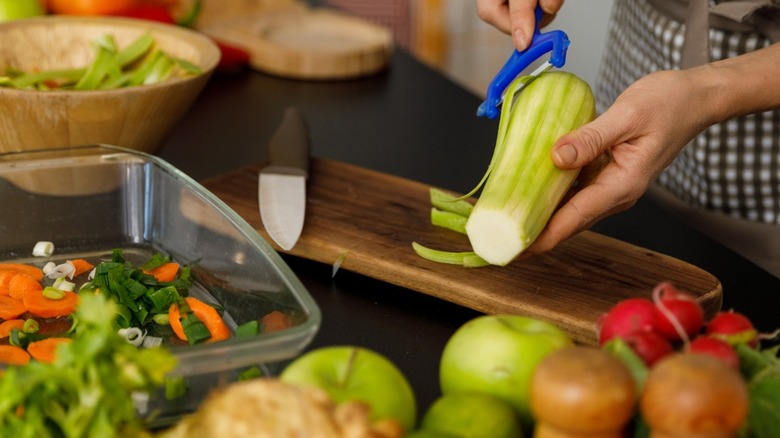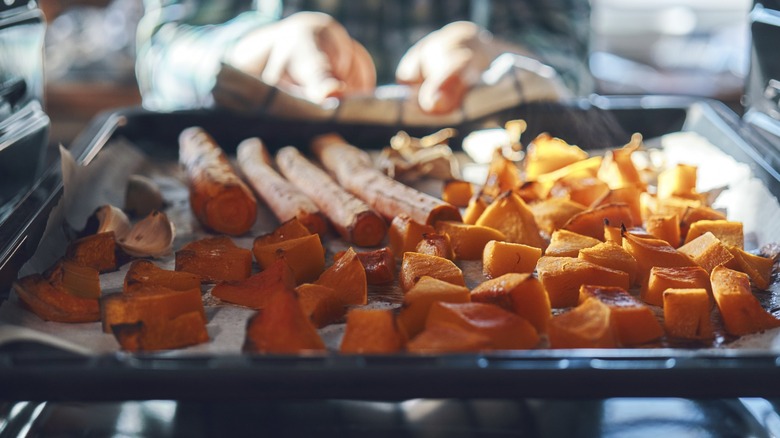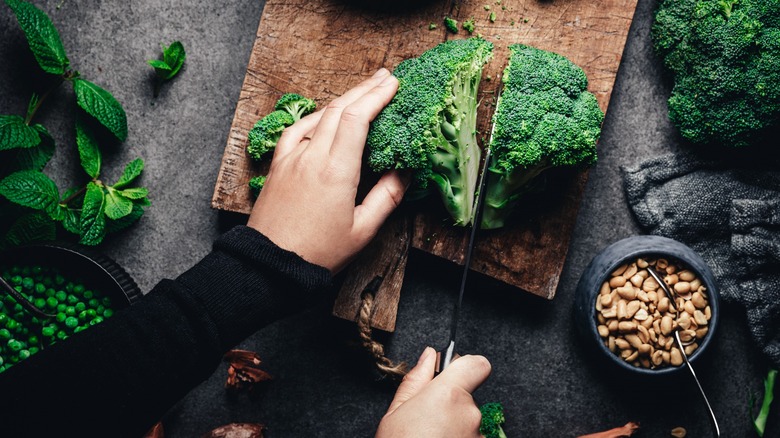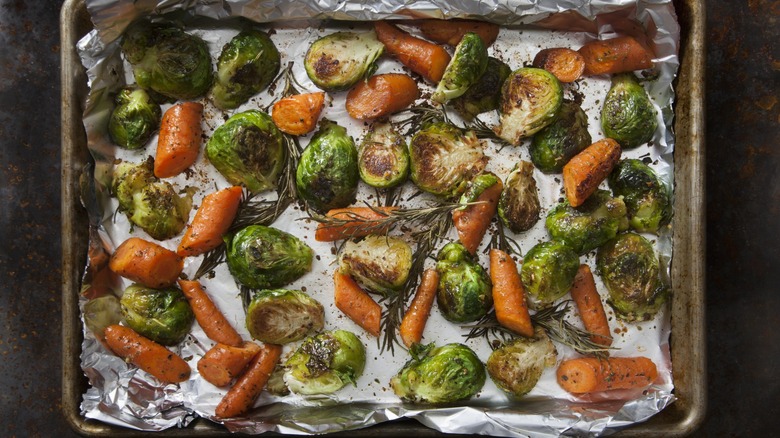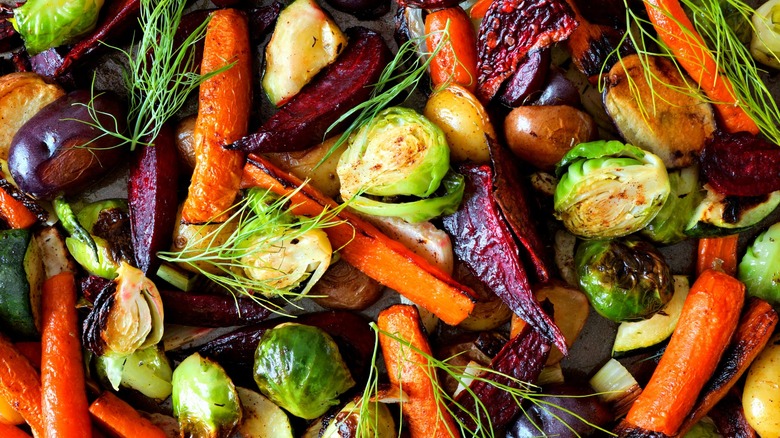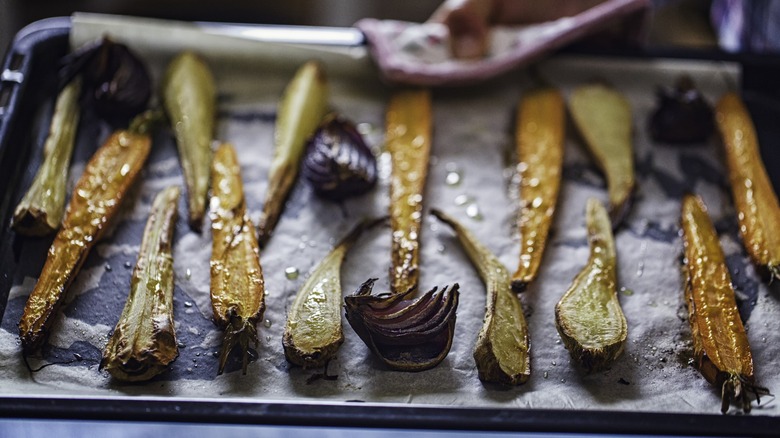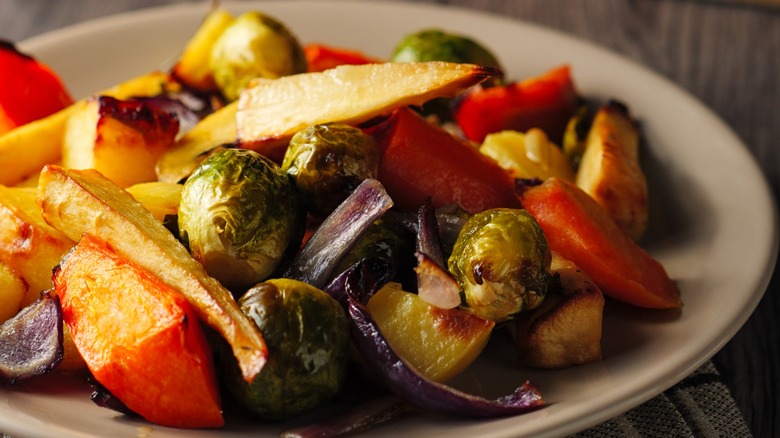Ina Garten's 7 Best Tips For Perfect Roasted Veggies
Roasting vegetables can transform ordinary produce into an elevated culinary experience, and it's also one of the simplest dishes any home chef can create. But achieving perfectly caramelized exteriors and tender interiors, while preserving the natural flavor of each vegetable, can sometimes be a challenge.
Ina Garten has mastered the art of roasting vegetables; throughout the years, the "Barefoot Contessa" star has shared many of her tips and tricks for achieving perfection every time. The famous chef, author, and host specializes in simple yet sophisticated recipes, and is a firm believer that a home-cooked meal doesn't have to be fancy to be good.
It's no wonder, then, that effortless vegetable-forward dishes are among some of her most popular recipes. Whether you're an experienced home chef looking to perfect your vegetable game or a novice in the kitchen seeking basic guidance, Garten's expertise can help you create roasted veggies that are nothing short of perfection. Below, a closer look at some of her helpful advice.
Wash and get to peeling
Naturally, the first step of preparing vegetables to roast is washing them, even those you plan to peel. A thorough rinse under the kitchen faucet, some light scrubbing, and drying with a paper towel ought to do the trick to remove most dirt and germs.
The next step is peeling the veggies that need to be peeled. It goes without saying that some vegetables should always be peeled before roasting (like butternut squash), but according to her roasted asparagus recipe, Garten suggests even peeling asparagus to reduce the tough texture of the outside skin. In general, peeling root vegetables (such as beets, carrots, and parsnips) will ensure dirt is entirely removed, enhance their texture and flavor, and make them more aesthetically appealing.
For the most part, Garten suggests peeling root vegetables before roasting, as in her roasted winter vegetable recipe. She leaves carrots unpeeled in certain recipes (like these orange-roasted rainbow carrots) and if that's the case, it's necessary to vigorously scrub the outside with a vegetable brush to ensure all the dirt is removed. Most importantly, make sure you're using a sharp vegetable peeler. Garten suggests replacing the tool once a year. "Vegetable peelers get rusty, they get dull," she explained to Food & Wine in 2020. "They're very cheap, so you can just throw them out and buy new ones."
Cook at high temperatures
Ina Garten suggests always cooking vegetables at a high temperature; anywhere between 400 F and 425 F is best. "You want to cook them at a high temperature so they get caramelized on the outside because all the sugars in the vegetables caramelize," Garten explained last year on "The Drew Barrymore Show." Caramelization is a chemical reaction that happens when the natural sugars in veggies begin to break down. This turns the vegetables golden brown and enhances their flavor, adding an unmatched sweetness and comforting toasty flavor.
Cooking at high temps will also promote the Maillard reaction, a chemical tête-à-tête between amino acids and sugars in food that contribute to the browning of the vegetables, yielding a deeply rich flavor. High temperatures will also allow the vegetables to roast more quickly — which is not only more convenient, but will also reduce nutrient loss. Ultimately, cooking quickly at high temperatures is key to bringing out the natural sweet and savory flavor of the vegetables while browning them to perfection.
Don't chop the vegetables too small
One thing Ina Garten always makes note of in her roasted vegetable recipes is the necessity of chopping veggies into large pieces. "The key to roasting vegetables is you want to make sure you have big chunks of vegetables," she says while preparing her Roasted Winter Vegetables, noting that the reasoning for this is that they will naturally shrink during the roasting process and you don't want to be left with tiny pieces. Smaller pieces are more likely to overcook, get soggy, and burn without ever reaching the optimal caramelization or texture.
A rough, large chop is ideal and makes prep all that much easier. Not to mention how much more visually appealing larger portions of vegetables look. That being said, one thing you do want to keep in mind is consistency of size. Make sure that your vegetable pieces are all roughly the same size, otherwise you risk an uneven roast.
Keep it simple with the seasoning
Garten is a big believer in the power of salt, and encourages others to be less afraid of it. "I'm a salt freak," Garten told Eater in 2022. "I think salt makes everything taste good and people are terrified of salt and it's crazy." She also notes in her Roasted Winter Vegetables recipe that a hearty amount of salt is necessary when roasting vegetables because "vegetables really use up the salt, so you want to make sure it's well seasoned."
Beyond salt, all that is needed is freshly ground pepper. Simple seasoning will enhance the taste of the veggies and let their natural flavor shine. It also makes the dish more versatile, and you'll be able to pair with a variety of other mains. But of course, if you do want to get a little more adventurous, Garten has roasted vegetable recipes where she peppers in dried or fresh herbs like rosemary or sprigs of thyme. The key, however, is to never overdo the seasoning to the point where it overpowers the flavor of the veggies.
Toss them in olive oil with your hands
When it comes to roasting vegetables, olive oil is Ina Garten's weapon of choice. After drizzling over the veggies and adding seasoning, Garten suggests tossing everything with the hands. Using your hands will allow for better control over the tossing process and ensure the oil is coated more precisely, preventing you from over-oiling some pieces while under-oiling others. When this happens, the veggies may cook unevenly and some will be soft while others will turn mushy.
Tossing with your hands, as opposed to metal utensils, will also ensure gentler handling and keep the veggies looking perfect. Just make sure your hands are nice and clean and thoroughly dry before touching any food. Then get to tossing. With this method, Garten reminds us our hands are sometimes our best tools and encourages us to never be afraid to get a little messy in order to connect with the food we're preparing.
Make sure there's space between the veggies
Perhaps one of the best tips Ina Garten has taught about roasting vegetables is the importance of spacing. In essence, never overcrowd a sheet pan. "You want to make sure that there's enough space between the vegetables so they don't steam," she explained on "The Drew Barrymore Show." If they steam, Garten says, they'll become mushy and will lose the slightly crispy exterior that roasting creates.
The gap between the pieces doesn't have to be super large, especially when considering that the vegetables will shrink as they roast. Just make sure they're in a single layer and not touching. To achieve this, it may be necessary to use a larger sheet pan. If roasting a large portion of vegetables and you can't fit them all in a single pan, it's probably a good idea to go ahead and use multiple pans — or alternatively, just roast them in batches. This extra effort is worth it to get better texture and flavor from the roasted vegetables.
Don't forget to flip halfway through cooking
Another helpful tip from the "Barefoot Contessa" host: Keep an eye on those vegetables, and always toss at the halfway mark. Unfortunately, roasting vegetables is never as easy as placing the sheet pan in the oven and waiting for perfection to happen on its own. You must check on the roasting process a few times to make sure the vegetables are cooking evenly and aren't getting too brown on one side. This may seem obvious, but it's easy to get distracted in the kitchen and forget, so it serves as a crucial reminder. Not only will remembering to flip result in a more even roast, it will also help prevent sticking, especially if using a non-stick sheet pan.
Once removed from the oven, the vegetables will be too hot to touch with bare hands, so use a spatula to gently flip the veggies. While it may be a hassle to have to remove the pan and turn all the pieces, it's essential to ensure the veggies brown more evenly.
